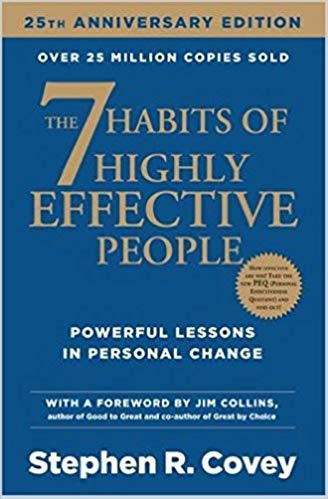

This article is an excerpt from the Shortform summary of "The 7 Habits of Highly Effective People" by Stephen Covey. Shortform has the world's best summaries of books you should be reading.
Like this article? Sign up for a free trial here .
Do you consider yourself a proactive person? What does a proactive approach to life entail?
In his book The 7 Habits of Highly Effective People, Stephen Covey defines proactivity as the ability to change the problems that you can change and accept the ones that you can’t. Being proactive requires taking full responsibility for your actions and decisions.
Continue reading to learn what proactivity entails, why it makes your life better, and how to cultivate it.
Be Proactive, Not Reactive
Understanding that we always have the power to choose our thoughts, feelings, and actions makes it clear that every situation presents a choice between being reactive or proactive.
- If you’re reactive, your conditioning dictates how you respond to people and circumstances. This is the outside-in approach: External factors affect how you feel inside. Your physical environment (e.g. the weather) and social environment (e.g. how people treat you) determine how you feel and act.
- If you’re proactive, you decide how you’ll respond to create the results you want. With this inside-out paradigm, you mindfully choose your thoughts and actions based on values you’ve chosen, cultivated, and internalized. You’re still subject to rain and your boss’s bad mood, but you suppress your reactive emotional impulses when you react.
Proactivity vs. Blind Optimism
According to Stephen Covey, proactivity is different from blind optimism.
- Blind optimism means minimizing a problem or denying that it exists entirely. (Shortform note: Similarly, toxic positivity is an insistence on maintaining a positive outlook, and in doing so it disregards all painful and difficult emotions. While often well-intended, this response causes shame and guilt for feeling bad, and it doesn’t allow people to feel and process painful emotions, which is necessary for growth.)
- Proactivity means accepting difficult realities and determining how to resolve or make the most of them.
This difference has been underscored in how people respond to systemic racial inequity, especially as the issue has been more broadly publicized and acknowledged in recent years.
- Blind optimists highlight increased awareness and activism, while glossing over persistent problems like swelling membership in hate groups and a slew of voter suppression laws.
- Proactive people recognize progress while recognizing the work that still remains, and they address those issues through efforts like community organizing. When they have achievements along the way, proactive people view them as motivation to keep pushing, rather than a signal that the work is done.
Proactivity Demands Effort
Among its many benefits, being proactive is a critical first step to improving your life, but it’s not always easy.
First, many people have let their proactivity muscles atrophy. Being proactive and taking initiative are actually natural human responses—but, just like a muscle, if you don’t practice these skills, they get weak. If you’ve spent years blaming your circumstances and conditioning (for instance, “My parents raised me with this dysfunction.”) for the problems in your life, it’ll take some deliberate practice to transition to a proactive paradigm.
Second, being proactive means you have to take responsibility for your actions and their consequences. Now that you know that you can choose your thoughts, feelings, and actions, you have to acknowledge that, explicitly or implicitly, you’ve chosen or allowed everything that’s happened in your life—good and bad.
How to Be Proactive
We’ve discussed what it means to be proactive, but how do you adopt a proactive attitude? Following are six strategies for becoming proactive: two big-picture approaches and four actionable tips.
Strategy #1: Big Picture—Don’t Concern Yourself With Issues You Can’t Affect
Covey describes proactivity as focusing only on issues you can impact. Put another way, don’t waste your energy worrying about problems you can’t affect.
Covey illustrates this by drawing a “Circle of Concern” around all of your thoughts and worries. Some of those thoughts and worries are within a smaller circle, inside the Circle of Concern—this is the Circle of Influence, which contains all the things that you can actually do something about. For example, the housing market slump is in your Circle of Concern, whereas your upcoming mortgage payment is in your Circle of Influence.
Covey asserts that reactive people focus on issues outside their Circle of Influence. Spinning their wheels on things they can’t control causes them unnecessary stress and reinforces feelings of victimization.
By contrast, proactive people spend their time and energy only on their Circle of Influence. Furthermore, they actually expand their Circle of Influence because, by definition, proactive people recognize and address the issues in front of them.
Strategy #2: Actionable—Expand Your Circle of Influence
The greater the number of concerns that fall within your Circle of Influence, the more control you have to eliminate the issues in your life and create change in your favor. Covey posits that you always have a choice in how you respond to a situation, and the key to expanding your Circle of Influence is learning how to respond with problems over which you have no direct control.
If you made a list of everything that worries and upsets you—from work stress to your kids fighting to climate change—each issue would fall into one of three categories, which Covey labels:
- Direct control—Problems that are directly related to your actions
- Indirect control—Problems that are related to other people’s actions
- No control—Problems that you have no ability to impact, including certain circumstances (like the the weather) and the past
Once you’ve identified what kind of issue you’re dealing with, take the proactive approach:
- For direct-control problems, alter your behavior. Habits 1 through 3 are focused on changing your actions through habits.
- For indirect-control problems, focus on your interactions with other people and you may be able to influence their actions. Habits 4 through 6 address this through “Public Victories,” which improve how you connect and communicate with others.
- For no-control problems, accept the unchangeable reality and make peace with it. Dwelling on the issue only empowers it to harm your mental and emotional well-being.
| Robert Cialdini’s Techniques of Influence and Persuasion When it comes to dealing with indirect-control problems, Habits 4-6 will discuss how to influence others from a Character-Ethic approach. However, building on that foundation, it helps to have some actionable Personality-Ethic techniques for influencing others. Marketing psychology professor Robert Cialdini outlined six psychological principles of persuasion in his bestselling 1984 book, Influence. To be fair, the book is meant to be a warning about manipulative techniques used by professional persuaders, such as salespeople and politicians—but it can also be read as a playbook. The six principles are: Reciprocity—If you give someone a small gift or favor, they’re likely to feel compelled to repay you with a favor in return. If you want someone to agree to a request, do something nice for them just because—and then ask. Alternatively, you can make an initial ask for something absurdly large, and then pretend to concede and return with a second, more reasonable request; the other person will feel inclined to agree because you’ve supposedly done the favor of settling for less. Commitment/Consistency—If someone has already committed to a decision or position, however small, they will go out of their way to maintain that commitment, even when it’s illogical. If you, as the persuader, start by getting someone to agree to something small, you can capitalize on the person’s commitment to working with you by making increasingly larger asks. Social Proof—People assume that if many people are doing the same thing, that must be the right thing to do. Thus, to influence someone to do something, emphasize that many other people are already doing that action. You can achieve this effect with testimonials and descriptors like “fastest-growing” and “highest-selling.” Liking—Someone is more likely to comply with requests from people they know and like, as well as with people who are associated with the known-and-liked people. In other words, when you’re asking someone to work with you, name-drop some mutual friends you’ve worked with. Also, be charming, look presentable, and make the other person comfortable; people are more open to requests from good-looking and likeable people, and people they believe like them. Authority—People are more inclined to comply with requests that are backed by experts and people in authority (even people with titles and uniforms that merely look authoritative). So, to get people to follow your call-to-action, find an authority figure to endorse your message. Scarcity—People find rare and exclusive things more appealing. As a result, you can make your offering more sought-after by making it appear scarce, as with limited-time-only and first-come-first-served promotions |
Strategy #3: Big Picture—Create Your Self-Paradigm
When it comes to becoming more effective (which is the goal, after all), Covey posits that the most critical paradigm is your self-paradigm: How you see yourself impacts how you see others and what you think, feel, and do. In other words, your self-paradigm can determine things like
- Whether you consider yourself a success or a failure
- Whether you are grateful or skeptical toward someone’s offer to help
- What kinds of thoughts keep you up at night
- What you do in your spare time
Covey asserts that it’s critical to your effectiveness that you consciously create your own self-paradigm—otherwise, your self-image will be based on the feedback you take in from other people’s opinions and actions toward you. That creates an inaccurate and disjointed self-understanding that causes you to behave dysfunctionally and ineffectively. The issue is threefold:
- Though Covey doesn’t explicitly make this connection, letting external forces shape the core of how you view yourself and the world is the epitome of an outside-in paradigm, which is a signature of reactivity.
- Covey’s description suggests your self-image would be unstable because it’s subject to the flux of which outside influences you’re exposed to and what message they’re sending at any given time.
- Covey argues that, if the people around you haven’t developed their own self-paradigms, their reactions toward you are based on projections of their own thoughts and fears (as are your reactions toward them).
Building on that, if your self-paradigm is based on external feedback that’s largely negative—for instance, if your mother, your teacher, or society is telling you that you’re destined for mediocrity—then you’re likely to act accordingly and create a self-fulfilling prophecy. Instead, Covey urges you to reject their opinions and use your four human endowments to decide for yourself what’s possible.
Merely imagining that anything besides your prescribed trajectory is possible can have life-changing effects, according to psychologist and researcher Carol S. Dweck. In her book, Mindset, she argues that the course of your life can be determined by whether you believe that your intelligence and abilities are unchangeable (a “fixed” mindset) or that they can evolve (a “growth” mindset).
Strategy #4: Actionable—Watch Your Language
As you become aware of your self-paradigm, notice the words and phrases you use. Covey urges readers to be mindful of the words and phrases they use, which suggests that language reflects and also reinforces proactive or reactive paradigms. For example, a reactive person would say something like, “I wish I didn’t have to work at a job I hate.” In reality, they made the choice to work at that job. They may have made the choice because the alternatives were worse, but it was a choice nonetheless. However, by failing to acknowledge that they had ownership of that decision, they reinforce a feeling of victimization and a lack of control, creating a self-fulfilling prophecy.
By contrast, a proactive person might say, “I’m working at a job I don’t like because it pays enough to help me pay off my debt, and I have a plan to get a better job when I’m debt-free.” They still acknowledge that they dislike the job, but they can own the decision to work there because they made that choice consciously and proactively; they have a clear why. (We’ll talk more about the importance of a strong why in Habit 3.)
Transform Your Vocabulary
Since 7 Habits’s publication, research findings have confirmed the benefits of using positive, empowering language—and the consequences of using disempowering language.
- In their 2012 book, Words Can Change Your Brain, a neuroscientist and a communication expert assert that using positive language over an extended time makes lasting changes in your brain. One result: You see yourself and others in a more positive light, and you may even view your entire reality more brightly.
- Additionally, the authors’ research revealed that using positive words stimulates the frontal lobe of the brain, where the regions that control your language and your movements connect. In other words, positive language triggers your brain to turn your words into action.
- Another study showed that negative words set off anxiety- and stress-inducing hormones.
To transform your vocabulary, Robbins (Awaken the Giant Within) suggests being especially mindful of your habitual questions and metaphors.
- Your habitual questions are primarily the questions you ask yourself, which triggers a sequence of thoughts on a subject. For instance, you’re struggling to master a new skill, and you ask yourself “Why can’t I get it?” This question is negatively framed, and it easily leads to thoughts like “I’m not good enough” and “I should give up.” By contrast, an empowering question like, “How can I alter my approach?” leads to more constructive thoughts.
- The metaphors you often use (such as, “Life is like a box of chocolates”) are particularly powerful because they evoke imagery that gives the phrase a bigger impact. The vividness of metaphors make them especially potent in influencing your thoughts, moods, and actions. For example, describing high crime rates as a beast of a problem that must be tamed has a more aggressive tone than saying that the issue is a social ill that needs to be diagnosed and treated from the source.
Strategy #5: Actionable—Learn From Your Mistakes
Proactive people acknowledge their mistakes and learn from them. Mistakes lie in your Circle of Concern: You can’t change or undo them. Covey explains that you have two choices when confronted with a mistake:
- Admit, accept, and learn from it. As mentioned, this is the proactive approach because it entails recognizing and addressing the problem on your terms, instead of letting the mistake bring you down. Instead of empowering the mistake, you put yourself back in control.
- Rationalize, minimize, or dwell on it. This is the reactive approach, which actually doubles the mistake, because trying to cover up a mistake puts more focus on it, thereby reinforcing it.
Learn from your mistakes as quickly as possible. Covey posits that the longer you go without learning from a mistake, the more likely you are to repeat it. This suggestion aligns with one of Tony Robbins’ habit-breaking techniques, which he calls pattern disruption: When you catch yourself doing the action you want to change, abruptly interrupt it with something totally random (for example, stand up and shout something ridiculous). The interruption doesn’t let the signals in your brain complete their usual course for that action; done consistently, these disruptions gradually weaken the brain wiring that triggers that behavior, which breaks the habit.
| Silicon Valley Celebrates Mistakes Mistakes—making and learning from them—are crucial to building knowledge, improving skills, and innovating. In Silicon Valley, failure is such a virtue in the tech industry that the unofficial mantra has become, “Fail fast, fail often” (though some say the emphasis on relentless ambition drives many to exhaustion). There’s even an annual conference called FailCon, where people in the industry swap stories about their failures. Netflix CEO Reed Hastings writes about the importance of talking about failures in his book, No Rules Rules, where he describes the philosophies that helped the company adapt and thrive. He insists that when leaders are transparent about their own mistakes, it builds trust with your employees and encourages them to take risks, too. |
Strategy #6: Actionable—Make Commitments to Yourself and Others
Taking action is one of the defining features of proactivity: Addressing problems will often require you to make and achieve a goal. Covey says to think of that goal as a commitment to yourself—you’re committing to taking steps to make concrete, proactive changes in your life. To increase your proactivity and overall effectiveness, make and keep commitments to yourself and to others.
Covey suggests a 30-day challenge to build your Circle of Influence. Make small commitments and goals and take steps to achieve them. These goals can be personal, at work, in your family, in your marriage, or in other relationships. As you do, remember:
- Maintain an inside-out paradigm: Don’t blame challenges on circumstances or other people.
- When you talk about your goals and progress, use empowering language.
- When you make a mistake, acknowledge it, correct it if you can, and learn from it.
Make More Decisions
In the same vein as Covey’s advice to make commitments, Robbins devotes one of the first chapters of Awaken to discussing how embracing decisions is fundamental to taking control of your life. He warns that neglecting your decision-making power and simply going where life takes you results in Niagara Syndrome: You’re subject to currents beyond your control, and you spend all your energy trying to avoid immediate threats—like rocks and waterfalls—that you have no resources to plan for the future.
Although it can seem like avoiding a decision is the easy way out, Robbins asserts that inaction is actually a decision to take a passive role in shaping your life and allow external factors to dictate your actions.
Take an active role in your life by embracing decisions—and some inevitable mistakes. Try these tips to make more decisions:
- Build your decision-making muscles. Practice making decisions at every opportunity. Start with small choices, like what to have for dinner, and work your way up.
- Don’t be afraid of making the wrong decision. Mistakes and failures are inevitable—learn from them. Once you embrace mistakes, instead of viewing challenges as potential failures, you’ll see them as opportunities to make critical decisions.
- View decisions as commitments. When you make a true decision, you cut yourself off from any other possibility. That commitment gives you clarity and focus, which are empowering.
- Don’t avoid a decision because you don’t know how you’ll achieve it. Trust that, if you’re truly committed to your decision, you’ll find a way to manifest it.
———End of Preview———

Like what you just read? Read the rest of the world's best summary of "The 7 Habits of Highly Effective People" at Shortform . Learn the book's critical concepts in 20 minutes or less .
Here's what you'll find in our full The 7 Habits of Highly Effective People summary :
- How to prioritize the hundred tasks you have to focus on the one or two that really matter
- The right way to resolve every disagreement and argument
- How to avoid burning out and succeed over 20+ years






